The First Amendment Guarantees ALL Freedoms, including a Truthful Press
Carteret County (1722)
Publisher's note: We believe the subject of history makes people (i.e., American people) smarter, so in our quest to educate others, we will provide excerpts from the North Carolina History Project, an online publication of the John Locke Foundation. This twenty-seventh installment, by the Carteret County Historical Society, is provided courtesy of the North Carolina History Project.
Carteret County, North Carolina was formed in 1722 out of Craven County. It is named in honor of Sir John Carteret, who later became the Earl of Granville and one of the Lords Proprietors of North Carolina.
Native inhabitants of the area were the Iroquois-speaking Tuscarora Indians. The Tuscarora Nation lived between the Neuse and Pamlico Rivers in eastern North Carolina. As early as 1706, white settlers of Huguenot, German, Scotch-Irish, French, and English descent arrived in the region. Most had migrated southward from northern American colonies rather than from Europe. Also, in 1721 Quakers from Rhode Island came in family units and settled on the north side of the Newport River.
Beaufort, Carteret's county seat, is the third oldest town in North Carolina. It was first known appropriately as Fishtown because the fishing industry was and has been an important part of the county's history. Beaufort was later named for Henry Somerset, Duke of Beaufort.
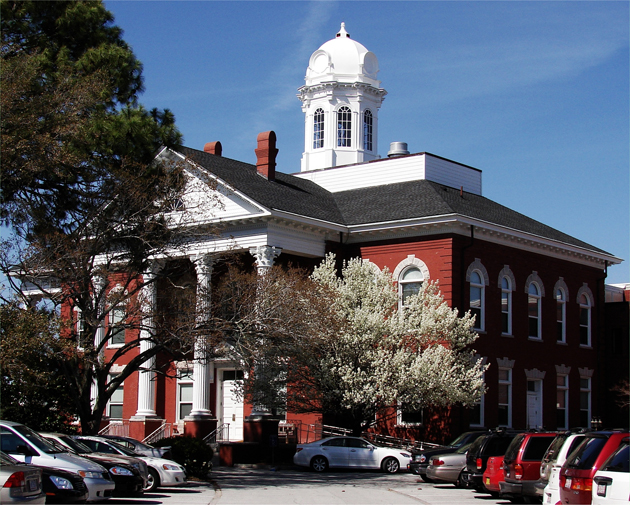
The Carteret County Government Building in the county seat of Carteret County, Beaufort: Above. The Confederate Soldier Memorial on the grounds of the county government campus: Below. photos by Stan Deatherage Click the picture to expand to as much as 1000 pixels wide within most expanded images, and then push the arrows embedded in the center edge of the play-box to access the gallery, and slide new images into viewing within the center of the screen.

The largest plantations, given by grants or purchased, were in the central and western parts of Carteret County. Large land owners included Robert Williams, William Borden, and the Stanton family. Unlike other parts of North Carolina and Virginia, no large pillared houses were constructed in the county; the Williams' plantation home, for example, was brick and plain.
Carteret County participated in global trade almost from its beginning. Plantations produced goods such as tobacco, grains, and salted meats and fish to export to England. Lumber was also a major export due to the area's vast forests. The most significant commercial industry was naval stores--tar, pitch, rosin, and turpentine.

The North Carolina Maritime Museum, along the waterfront in Beaufort, provides a visual history to Carteret County: Above. This fishing boat docked on the shore of the Newport River is a symbol of economic viability of Carteret County: Below. photos by Stan Deatherage Click the picture to expand to as much as 1000 pixels wide within most expanded images, and then push the arrows embedded in the center edge of the play-box to access the gallery, and slide new images into viewing within the center of the screen.
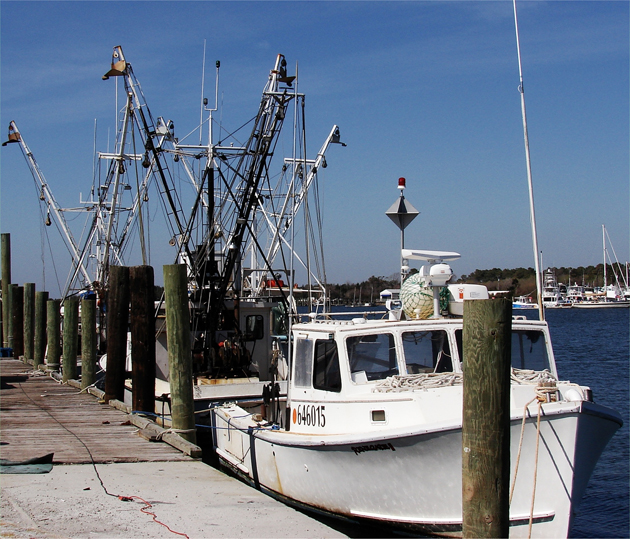
Portsmouth and Beaufort served as the county's major ports. Ships landed in Portsmouth, and workers transferred cargo to smaller boats for transport to the mainland. However, as its depth decreased, Portsmouth harbor declined as a port of entry, and the town was abandoned.
Formal education was not a priority for the early settlers of Carteret County. Most children were preoccupied with working on the farms. Wealthier families usually sent their children outside the colony for advanced training. In the community of Hunting Quarters, however, the Scotch-Irish established the area's first school; it became the first accredited high school in the county. The first Anglican Church in Beaufort, St. John's Parish, was organized approximately in 1724. However, the increasing opposition of Baptists, Quakers, and other denominations contributed to the decreasing number of Anglicans in Carteret County.
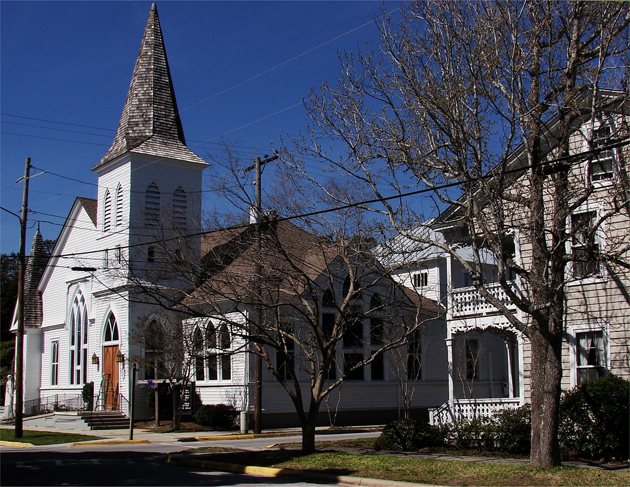
On the campus of the Ann Street United Methodist Church is where the oldest graveyard in Beaufort is located: Above. photo by Stan Deatherage
Carteret countians have witnessed war in their backyards. Many served in the Revolutionary War, and naval skirmishes occurred in the county's waters. Constructed between 1826 and 1834, Fort Macon was the site of a major battle during the Civil War. On April 25, 1862, Confederate troops surrendered the fort, and the Federal Government used Fort Macon as a prison following the war.
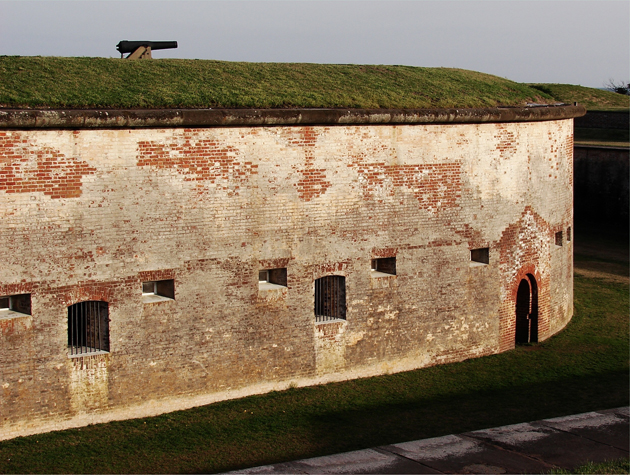
Fort Macon standing guard over the the Beaufort Inlet: Above. The sand, the foam, and the Beaufort Inlet leading to the Atlantic Sea, as we look south east while in the shadows of Fort Macon: Below. photos by Stan Deatherage Click the picture to expand to as much as 1000 pixels wide within most expanded images, and then push the arrows embedded in the center edge of the play-box to access the gallery, and slide new images into viewing within the center of the screen.
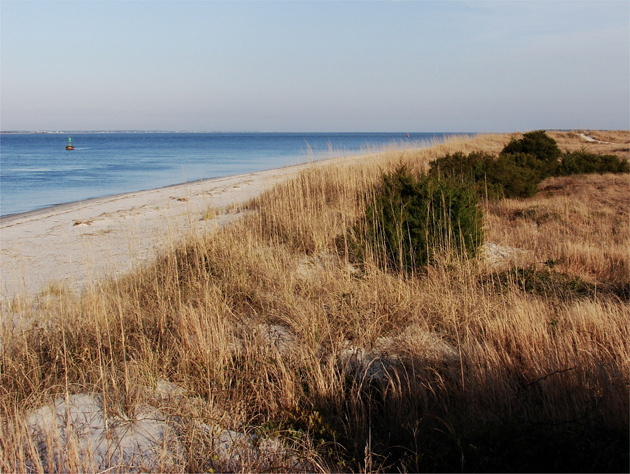
Although most of the settlements were developed prior to the Civil War, Morehead City was not established until 1858. It started as a railroad town and eventually attracted tourists. Today, tourism has replaced agriculture and exporting as Carteret County's largest industry.
Sources:
Heritage of Carteret County 2 Vols. (Carteret County Historical Society, 1982).
Go Back
Carteret County, North Carolina was formed in 1722 out of Craven County. It is named in honor of Sir John Carteret, who later became the Earl of Granville and one of the Lords Proprietors of North Carolina.
Native inhabitants of the area were the Iroquois-speaking Tuscarora Indians. The Tuscarora Nation lived between the Neuse and Pamlico Rivers in eastern North Carolina. As early as 1706, white settlers of Huguenot, German, Scotch-Irish, French, and English descent arrived in the region. Most had migrated southward from northern American colonies rather than from Europe. Also, in 1721 Quakers from Rhode Island came in family units and settled on the north side of the Newport River.
Beaufort, Carteret's county seat, is the third oldest town in North Carolina. It was first known appropriately as Fishtown because the fishing industry was and has been an important part of the county's history. Beaufort was later named for Henry Somerset, Duke of Beaufort.


The largest plantations, given by grants or purchased, were in the central and western parts of Carteret County. Large land owners included Robert Williams, William Borden, and the Stanton family. Unlike other parts of North Carolina and Virginia, no large pillared houses were constructed in the county; the Williams' plantation home, for example, was brick and plain.
Carteret County participated in global trade almost from its beginning. Plantations produced goods such as tobacco, grains, and salted meats and fish to export to England. Lumber was also a major export due to the area's vast forests. The most significant commercial industry was naval stores--tar, pitch, rosin, and turpentine.


Portsmouth and Beaufort served as the county's major ports. Ships landed in Portsmouth, and workers transferred cargo to smaller boats for transport to the mainland. However, as its depth decreased, Portsmouth harbor declined as a port of entry, and the town was abandoned.
Formal education was not a priority for the early settlers of Carteret County. Most children were preoccupied with working on the farms. Wealthier families usually sent their children outside the colony for advanced training. In the community of Hunting Quarters, however, the Scotch-Irish established the area's first school; it became the first accredited high school in the county. The first Anglican Church in Beaufort, St. John's Parish, was organized approximately in 1724. However, the increasing opposition of Baptists, Quakers, and other denominations contributed to the decreasing number of Anglicans in Carteret County.

Carteret countians have witnessed war in their backyards. Many served in the Revolutionary War, and naval skirmishes occurred in the county's waters. Constructed between 1826 and 1834, Fort Macon was the site of a major battle during the Civil War. On April 25, 1862, Confederate troops surrendered the fort, and the Federal Government used Fort Macon as a prison following the war.


Although most of the settlements were developed prior to the Civil War, Morehead City was not established until 1858. It started as a railroad town and eventually attracted tourists. Today, tourism has replaced agriculture and exporting as Carteret County's largest industry.
Sources:
Heritage of Carteret County 2 Vols. (Carteret County Historical Society, 1982).





















